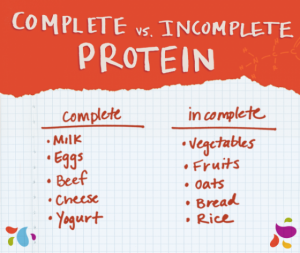Amino acids are considered to contain “complete protein”
The human body requires protein for many reasons, so it is important to consume sufficient amounts of high protein foods. A good rule of thumb is to consume 0.75 grams of protein for every pound of body weight; e.g., 120 grams for a 160-pound person. This amount of daily protein intake can aid in the prevention and even reversal of osteoporosis. For athletes and active people who require additional tissue repair, protein intake should be increased. 
These figures assume that you eat a mixed diet of proteins that match the amino acid ratios required by the body. There are twenty-two different amino acids that are important to the body. These combine together in thousands of intricate biochemical patterns to create a variety of complex protein structures. Nine of the amino acids are “essential” — the body cannot produce them so they must be supplied from whole food sources.
Foods that supply a specific ratio of the nine essential amino acids are considered to contain “complete protein.” Virtually all proteins from raw animal foods are complete. Foods that lack one or more of the essential amino acids, such as certain fruits, grains and vegetables, contain “incomplete protein.” Plant foods can be excellent sources of protein if eaten in combinations that supply the balance of essential amino acids. For example, in Latin cultures, the incomplete amino acid profile of beans combined with incomplete whole grain rice creates a balanced complete amino acid profile.
Essential Amino Acids
Histadine
Isoleucine
Leucine
Lysine
Methionine
Phenylalanine
Threonine
Tryptophan
Valine
Nonessential Amino Acids
Alanine
Arginine
Asparagine
Aspartic acid
Cysteine
Glutamic acid
Glutamine
Glycine
Ornithine
Proline
Serine
Taurine
Tyrosine
When we eat whole foods, a healthy digestive system breaks proteins down into its amino acids that enter the body’s “pool” of amino acids. Each cell assembles the proteins it needs using the amino acids as building blocks. If one or more of the “nonessential” amino acids is in short supply, the body can produce it from essential ones.
However, low consumption of any essential amino acid can limit the body’s effective use of the others. The body then cannot form protein, and isolated amino acids begin to accumulate in the bloodstream. Missing one of the essential amino acids is like trying to build a car on an assembly line without the engine. Supplies of tires, chassis, seats, brakes and windows keep arriving, but no cars can be completely built. Meanwhile, inventory of all these parts creates congestion in the manufacturing plant.
We need the nine essential amino acids in our diet as raw materials in just the right proportions and at the same time. It does little good taking in a few essential amino acids one day and getting the others later in the week.